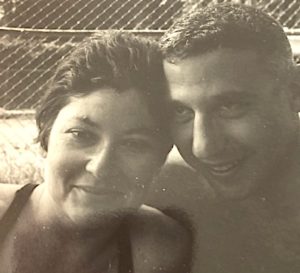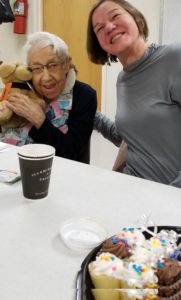“In That Number” Book Launch hosted by Skyline Village Chicago via zoom, Oct 21, 2020, 4:00 pm Chicago time with NPR/WBEZ reporter Monica Eng. Register here
 Cousin Barb Violi, Omaha Nebraska
Cousin Barb Violi, Omaha Nebraska
In another world and time uncertain, we’d be having a rip-roaring party at Half Sour in Chicago’s South Loop hosted by Beth Finke and Mike Knezovich. Iliana Genkova would pass around campaign-like buttons and cookies with the name of my book tattooed on top. We’d all be happy, joyous and free for a few brief hours away from the worries of the world.
Sigh. We’ll have to settle for a Zoom Book Launch. Please pull up your own refreshments and join us. Monica Eng has graciously agreed to lead the discussion for my book. You’ve heard her reporting on Curious City (most recently about rats!), Thursdays on WBEZ’s “All Things Considered”.
I’ve always wanted to be a published author but I never dreamed my writing would be so well received outside of a small circle of friends and fellow writers. I’m truly humbled. Thank you for reading my book and paying such generous compliments to me in person, on email and text, Face Book and Twitter and Zoom, and even a card in the mail!
A particular thank you to those who’ve encouraged me to compile years worth of 500-word essays from memoir writing classes into a book. It was a harder task and a longer trip than I imagined but well worth the effort. If you’re a writer, keep laying down those words. There’s power in the story. If you’re not a writer, thank you for supporting us; allowing us to make mistakes, grow weary, and to brag when we find that one perfect word for that one perfect sentence in that one perfect paragraph.
Allow me to share my joy with you through a smattering of quotes. In order not to embarrass anyone, I’ve kept most anonymous.
See you October 21!
- I passed two days immersed in your life story. I identified with so many places and events. I am 100% with you on the last paragraph on page 246.
- The beauty and skill of every page, and the achievement of presenting your life story of engaging encounters is thrilling. That’s what made me want to read it all.
- Helloooooo, It’s incredible. Who knew our white-haired “older” friend had such an XXX-rated past? I await the movie!!
- It’s a great book about a great woman!
- My dog wants to know why I get so absorbed in Regan Burke’s terrific book “In That Number.” But it’s easy to get caught up in this fascinating memoir of life, love, addiction and local and national politics.
- …a work as sui generis as Regan Burke herself. I have a feeling that we’ll look back on this event as more than a book launch – more like an opus launch, with much more to come after this one!
- It’s a fantastic memoir about alcoholism and politics, family and recovery, from a woman who’s met everyone from Bill Clinton to Vladimir Putin. (And Rick Perlsteinsays it’s great.)
- My husband read your introduction out loud to me last night. So well written –you had to get a lot into that short intro. “Want me to read the whole book to you?” He offered, “you know I could.” He hasn’t offered to read a book out loud to me in decades. Can’t say that I blame him: when he used to read to me, I’d fall asleep, often without him knowing. There he’d be, diligently working to read out loud, take a brief look up and…zzzzzz. He must feel confident I won’t sleep through this one. He’s right..
- Pot brownies at her sister’s wedding.





 . I’m enjoying this book. It’s so well written.
. I’m enjoying this book. It’s so well written. - This story is appealing to many different groups. It’s a redemption story, a woman’s empowerment story, an AA story, a friendship story, a political struggle story, a “how I did it,” story, a slice of baby boomer history and Rock-in-roll , and a special Chicago/Illinois-political tales story all wrapped up in one book.
- This is a beautiful wonderful story about a smart strong woman who faced all kinds of adversity and succeeded and built deep friendships. Also the context of a couple of decades (yikes, we’re talking decades) is fun. There are so many parallels between the 60s/70s and now. It’s a story that has all sorts of resonating themes.
- Am so delighted with this book – she is a brilliant writer and its a brilliant story of a life so well lived despite all the huge odds – the whole world should know.
- Who will like this book: 1. Anyone who likes Allan Sorkin shows, and Primary Colors. 2. Aging boomers who like the music, and a brief recount of early early political activists. 3. AA members 4. Democrats 5. Every Democratic political junky in or formerly from Chicago/Illinois 6. Gary Hart and Bill/Hilary Clinton supporters 7. Dead Heads and vintage rock-n-rollers 8. Every person who likes heros who survived struggles and find purpose (half of the best sellers list is this theme). 9. Anyone who’s been to Bahamas, Barcelona, Chicago, Dupont Circle, the Capital, the White House!
- I am on the second chapter and have many superlatives to expend— she is a wonderful writer, sharp, fun, exacting, goes to the heart of the matter.
- I’m so enjoying this book. I have to use a magnifying glass to read it. I really laughed at the lima bean story. My kids didn’t like them either. But I told them I had spent hours stuffing peas with mashed potatoes.
- Masterfully written, this memoir takes you on a true adventure – it starts with an eventful childhood, through the ups and downs of youth, the dealings with alcohol, drugs and religion, to making it to the highest echelons of politics. In That Number is inspirational and moving. Loved it! This is a book you must read, and you will read it in one go!
- What a life’s story! I smiled, gasped, whimpered, and rejoiced as I traveled with Regan though her extraordinary life.
- I love her writing style. She writes with intimate detail, intelligence, wit, and profound insight. Plus, it is a book for our present moment. I highly recommend “IN THAT NUMBER”.
- “I could not put down this memoir. It is a tale of redemption and rebirth. Regan Burke writes of all the pain of growing up the daughter of two alcoholics and well-dressed grifters ‘who didn’t pay their bills, lied, and cheated, but still had cocktails and hors d’oeuvres every night before dinner.’ Her story is that of the Baby Boomer generation: from sex, drugs, and rock and roll, to various political campaigns in Illinois, and finally to the Clinton White House and beyond. In That Number is a touching narrative of survival, loyalty, and compassion from a woman who has seen it all.” – Dominic A. Pacyga, author of Chicago: A Biography
- “I highly recommend this wise and wonderful memoir about politics, about families, and the politics of families. Reagan writes like an angel-and sometimes, even better, like the devil.” – Rick Perlstein, best-selling author of Nixonland and Before the Storm
- “Regan’s unmitigated honesty in In that Number serves as inspiration and challenges each of us, even in the face of adversity, to live, see the birds, and reach higher for ourselves and our communities every day, and in every way we can.” – Laura Schwartz, White House Director of Events for President Clinton, and author of Eat, Drink and Succeed
- “Tales of early life with a flim-flam father, Woodstock years of drugs and alcohol, and working in Bill Clinton’s administration…Regan Burke weaves her life story in a refreshing, artful, and oftentimes witty style that endears readers to the author and leaves us wanting more. What will she do next?” – Beth Finke, author of Writing Out Loud: What a Blind Teacher Learned from Leading a Memoir Class for Seniors
- I was so happy to receive your book. I read it within a week, maybe too quickly, excited to follow your narrative and really enjoying the flashes of recognition as I came across pieces I remember from classes at CLL. So much great writing in these pages. I also love the way your writing journey bookends the story and serves as inspiration for readers—the Epilogue leaves us on such an uplifting note. I’ll be thinking of you and hoping your book-debut experience is as joyful and satisfying as it can be. Congratulations again on the results of all your hard work. I think you did an amazing job! – Linda Miller, Teacher, Memoir & Creative Writing, Center for Life & Learning, The Clare and Newberry Library


